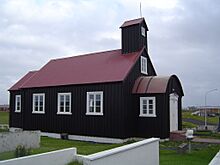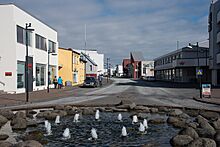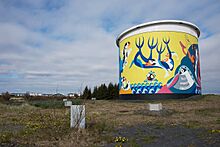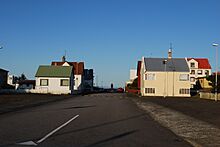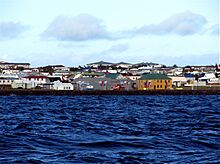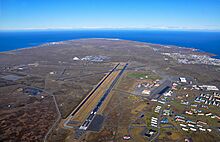Reykjanesbær facts for kids
Quick facts for kids
Reykjanesbær
|
||
|---|---|---|
|
Municipality
|
||
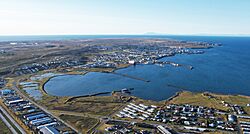
Aerial view of Reykjanesbær
|
||
|
||
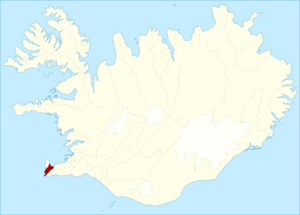 |
||
| Country | Iceland | |
| Region | Southern Peninsula | |
| Constituency | South Constituency | |
| Area | ||
| • Total | 145 km2 (56 sq mi) | |
| Population
(2021)
|
||
| • Total | 19,724 | |
| • Density | 130.49/km2 (338.0/sq mi) | |
| Postal code(s) |
230, 232, 233, 235, 260
|
|
| Municipal number | 2000 | |
Reykjanesbær (pronounced RAY-kya-nes-byr) is a town located on the Southern Peninsula in Iceland. It's a special kind of town called a municipality. Locals often use the name to talk about the areas of Keflavík and Njarðvík, which have grown together over time.
The municipality of Reykjanesbær includes three main places: the towns of Keflavík and Njarðvík, and the smaller village of Hafnir. These three places decided to join together in 1994. This made Reykjanesbær the fourth largest municipality in Iceland. In 2021, about 19,676 people lived here.
Contents
About Reykjanesbær
Keflavík is the biggest of the three towns that make up Reykjanesbær. Hafnir is the smallest and is about 10 kilometers away. Keflavík and Njarðvík used to be separate towns. But they slowly grew closer during the second half of the 1900s. Eventually, only one street separated them! One side of the street was Keflavík, and the other was Njarðvík.
Since May 2009, the town of Njarðvík has been home to the Viking World museum (Víkingaheimar). This museum is a popular place to learn about Vikings.
In 2006, the United States Navy closed its base, Naval Air Station Keflavik. A development group called Kadeco took over the area and renamed it Ásbrú. Now, Ásbrú is a busy place with a university called Keilir. It also has campuses for different schools and many businesses. Some of these businesses are new, and others moved there from other places.
Who Lives in Reykjanesbær?
Reykjanesbær is the most populated municipality in the Suðurnes region of Iceland. It's also the fourth most populated municipality in the whole country. It has the most people outside of the Greater Reykjavík area.
On January 1, 2019, about 18,920 people lived in Reykjanesbær. This is about 5.3% of all the people in Iceland. The Suðurnes region, which includes Reykjanesbær and five other municipalities, had about 27,113 people. This is about 7.6% of Iceland's population.
Many people from other countries live in Reykjanesbær. On January 1, 2018, about 24.4% of the people living in the town were immigrants. The largest groups of foreign citizens were people from Poland, Lithuanians, and Latvians.
Cool Places to Visit
There are several interesting places to visit in Reykjanesbær:
- The Icelandic Museum of Rock 'n' Roll: A museum all about Icelandic music.
- Naval Radio Transmitter Facility Grindavik: A radio station.
- Reykjanesviti: An old lighthouse.
- Viking World museum: A museum where you can learn about Vikings and see a replica Viking ship.
Friends Around the World
Reykjanesbær has "sister cities" in other countries. This means they have a special friendship and often share ideas and culture.
 Kerava, Finland
Kerava, Finland Trollhättan, Sweden
Trollhättan, Sweden
Gallery
- Reykjanesbær
-
Aerial view of Keflavík International Airport
See also
 In Spanish: Municipio de Reykjanesbær para niños
In Spanish: Municipio de Reykjanesbær para niños



